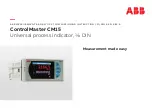
2 of 4
WX-501-0520 • 01.22
Communication Ports
There are six screw terminal blocks on the Click 200, each containing four screw terminals. The three blocks on
the top of the module are protected (check for the PROTECTED label to be sure you have the correct side) and
the three on the bottom of the module are unprotected. These screw terminal blocks are for wiring power, ground,
and communication (RS-232 and RS-485) between the Click 200 and the sensor (or the sensor block, which is in
turn connected to the sensor). They will be discussed in greater detail in the Installation section of this document.
There are also two other ways to wire RS-485. The back of the Click 200 features a 5-position connector that
plugs into a T-bus connector and provides power and RS-485 communication to the device. It also passes that RS-
485 communication to all other devices on the T-bus. In addition, the faceplate of the Click 200 features an RJ-11
jack for RS-485 communication. This jack can be used to connect a jumper cable from the Click 200 to contact
closure cards or to another device that uses RS-485 communication.
The front of the device also features a DB-9 connector for RS-232 communication.
Note.
The Click 200 does not convert RS-232 to RS-485 or vice versa. Connecting to the DB-9 connector will
allow you to communicate with the sensor using RS-232 protocol, but not using RS-485 protocol. You will also not
be able to use the DB-9 connector to communicate with other devices over the T-bus. If you need to convert RS-
232 to RS-485, use another Click module such as the Click 304.
A pinout diagram is provided on each individual unit as a reference in the field.
Note.
Certain newer Click 200 devices also have an LED on the faceplate. This LED, if present, lights up to
indicate power is present and surge protection is okay. If the light is off, either there is no power to the device or
surge protection is currently not ready.
Power Connections
The Click 200 receives power from the T-bus via the T-bus connection on the back of the module. Additionally,
if the power supply is not wired directly into the T-bus, power can be connected to the +DC and -DC screw
terminals on the UNPROTECTED side of the module. In this case, the Click 200 will then pass power through the
T-bus to all other devices connected to it.
Installation
To install the Click 200 in a pole-mount cabinet, simply mount it on the DIN rail and wire the service end of the
sensor cable into the PROTECTED side (see the section on wiring for how to do this).
In many installations, the pole-mount cabinet is also connected to a main traffic cabinet via an underground
homerun cable. To protect the traffic cabinet, a second surge device is required.
Note.
If any part of the cable goes underground, it’s necessary to have a Click 200 on each end of the cable to
protect the traffic cabinet and pole-mount box from electrical surges.
Follow the steps below to include surge protection using Click 200 devices (see the figure below):
1. Install a Click 200 device in a pole-mount box on the same pole as the sensor being protected.
2. Install another Click 200 in the main traffic cabinet.
3. Connect the cable from the sensor to the PROTECTED side of the Click 200 in the pole-mount cabinet. The
SmartSensor cable should be kept as short as possible.
4. Connect a cable from the UNPROTECTED side of the Click 200 on the pole to the UNPROTECTED side of the
Click 200 in the main traffic cabinet (see the section on wiring for how to do this).






















